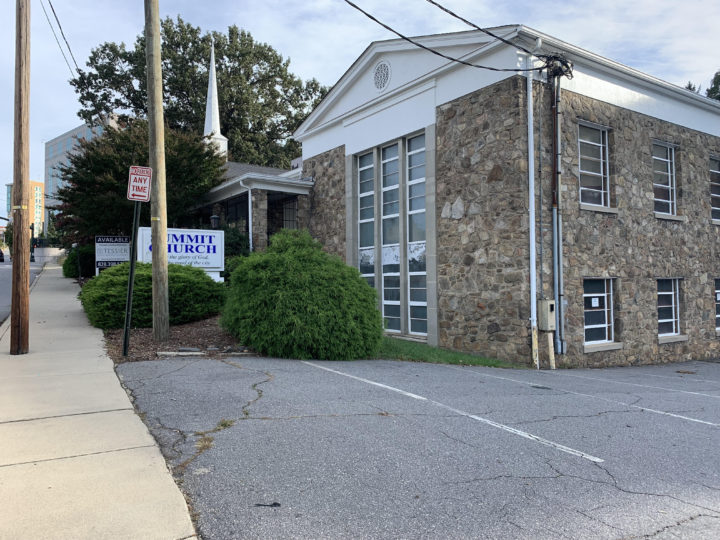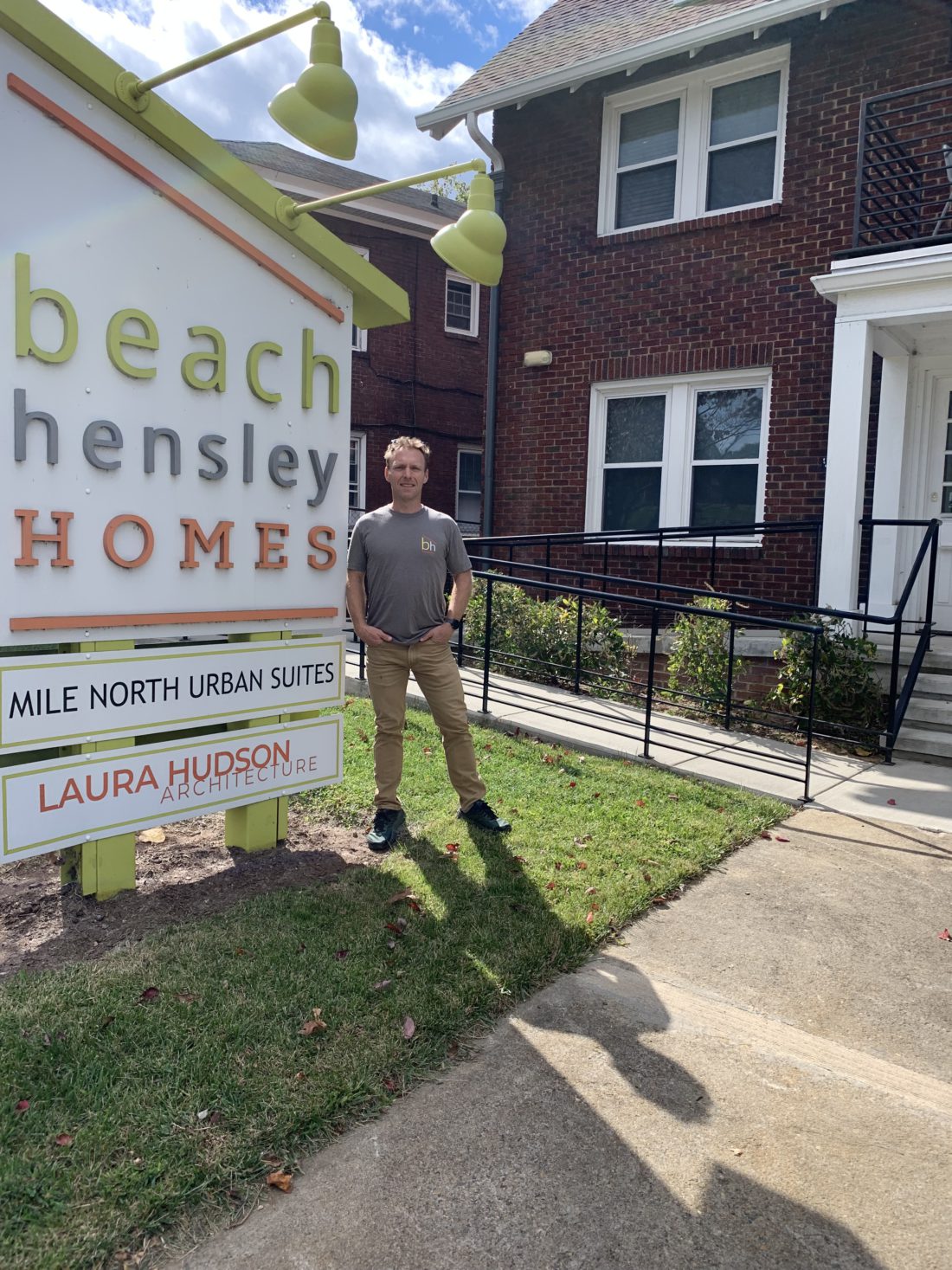When Beach Hensley was looking for an office for his homebuilding business in the summer of 2018, he found a former dental office on Merrimon Avenue that had sat empty for years.
“It had good bones, so renovation didn’t require major work,” Hensley recalls. “To get the location we wanted and make it financially feasible, we needed to have extra space to lease.”
To that end, he rents an office to a local architect and created two upstairs units he rents through Airbnb. The owner of Beach Hensley Homes says he’s grateful he was grandfathered in when the city created short-term rental restrictions. “Otherwise, I wouldn’t be able to afford this location,” he explains.
Hensley understands that some business owners don’t want to be on a busy thoroughfare but laments the overabundance of empty properties along Merrimon and other crucial corridors. Right next door to his office sits a vacant firehouse, built in 1927, that’s still owned by the city. Hensley says he regularly sees squatters there.
Countless existing structures of every shape and size remain vacant throughout the city, many in decrepit condition after years with no occupants. Although Asheville ranks among the top 11 commercial real estate markets in the country according to the National Association of Realtors’ Q3 2021 Commercial Real Estate Metro Market Report, 26% of currently available commercial space is vacant, including industrial, multifamily, retail and office properties.
Picking up the pace
The 392-page Living Asheville plan, a long-term development guide that City Council adopted in 2018, cites both “the need to balance preservation of the natural and built environment while accommodating population growth and the need to provide new and diverse housing that is priced affordably for the city’s residents.” The city spent two years developing the plan and an equivalent amount of time defining four opportunity zones for future mixed-use development.

In the meantime, however, Asheville and environs have continued to experience significant development pressures and a lack of affordable housing — yet some of the city’s busiest corridors are lined with vacant properties sporting “for lease” or “for sale” signs. Consider, for example, the blocklong parcel of land at the corner of Merrimon and W.T. Weaver Boulevard. While the 1.1-acre site has its challenges, including its narrow shape and adjacent creek, commercial real estate broker Karl Nelson of NAI Beverly-Hanks says it’s a prime location for privately owned student housing or a mix of multifamily units and retail.
“Sure, it’s going to take creativity and some easing of codes from the city,” Nelson concedes. “But some of the buildings could even be repurposed now while the rest is developed.” For this to work, the new construction would need to be taller than what the current code allows, he says.
Even as controversy continues a few blocks away over proposals to tear down houses and eliminate trees along Charlotte Street, the Merrimon location sits ready for action. And farther down the avenue, another block of aging, vacant buildings sits on 1.3 acres at the corner of Sandon Drive. Jason Burk of Whitney Commercial Real Estate Services says the owner of the former dental office (now vacant more than 15 years) and Subway shop (empty for nearly two years) is open to either leasing the existing structures or razing them and redeveloping the site for a new buyer or tenant.
“It’s really about what’s more financially feasible for the investor,” says Burk. “But people love converted property.”
Minding the bottom line
When workable, it’s almost always cheaper to repurpose than to build from scratch, says Michael Hoffman of Tessier Property Brokerage & Management. He represents the GBX Group, which bought an old church at 16 S. French Broad Ave. about three years ago. Built in 1929, the downtown structure has been vacant for close to two years but has considerable potential, Hoffman maintains. “It’s perfect to convert for an entertainment venue,” he says. “There’s a big stage in the former sanctuary. It would also be great for office space, an art gallery or charter school.”
And to ensure that the building doesn’t get torn down, GBX, which specializes in redeveloping urban structures, placed it under a historic preservation easement. “We’ve been approached by a number of hotels,” notes Hoffman. “They come out of the woodwork when a property like that becomes available.”
Many churches and banks have faced economic hardships and consolidations in recent years, leaving Buncombe County’s landscape rife with empty buildings. In East Asheville’s Gashes Creek area, new hillside office building development continues across U.S. Highway 74A from a bank that’s been vacant for about 2 1/2 years.
“The best use is always to repurpose,” counsels commercial real estate broker James Wilson of Pulliam Properties, who represents the former bank site. He says he’s had some calls about the property, noting that “New development helps draw interest to existing space. But it’s the financial bottom line that’s always the driving force for investors and developers.”
Thinking inside the big box
Biltmore Church’s leadership believes that seeking out feasible sites for adaptive reuse is the best way to manage their resources. “Why would we go out and build something brand-new when we can be a steward of the land and of our community finances?” asks Carl Setterlind, the pastor of creative ministries. “It’s just a win-win.”

Until 2012, the church had a single location in Arden. But rather than continuing to expand that site, its leaders decided to establish outposts in various neighborhoods. They now have a half-dozen campuses and say they haven’t had trouble finding suitable empty buildings.
“We always keep our eyes open for places to retrofit,” says Setterlind. The church’s most recent renovations involved a former Bi-Lo grocery store on the Smokey Park Highway in West Asheville. “We kept the form of the storefront, and we fit in well with the look of Gold’s Gym and other stores there.”
The same kind of seamless transition is evident in the former Kids R Us store on Fairview Road in East Asheville, which now houses a smooth, modern-looking Biltmore Church. The Hendersonville branch occupies a former NASCAR garage that was used by Andy Petree’s No. 33 racing team. The church even kept the roll-up doors.
Filling in the blanks
As undeveloped land becomes scarcer in high-density urban areas, repurposing existing structures may turn out to be the best approach for multifamily units, retail stores, offices, storage and even industrial applications. Retrofitting enables developers to add features to the property such as smart technology and energy-efficient upgrades that can drive higher lease rates. At the same time, small, empty parcels of land and viable empty buildings may provide answers for a city where housing prices are soaring.
“Affordable housing is dense housing,” says Nelson of NAI Beverly-Hanks. “We just need someone with the vision to take advantage of these valuable spots and a willingness by the city to be flexible.”
And as city leaders seek ways to accommodate growth while preserving key aspects of its current natural and built environments, Beach Hensley maintains, they could loosen some of the building code restrictions and zoning regulations that can hinder adaptive reuse. Citing the costly changes he had to make to add an outside fire escape to the back of his building, he says, “They can make retrofitting prohibitive.”




The architect of the so-called vacant fire station is Douglas Ellington. I’m aggravated that it was mentioned almost dismissively and am wondering what the city’s plans are for a building designed by one of Asheville’s most important architects. Thanks!